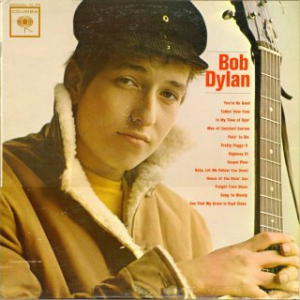by Patrick Roefflaer
Bob Dy lan
lan
- Released: March 19, 1962
- Photographer: Don Hunstein
- Sleeve notes: Robert Shelton
- Art-director: John Berg
Columbia Records
On October 26, 1961, Bob Dylan signs a record deal with Columbia Records in New York City.
The fact that he ends up at Columbia – one of the largest American record companies – is a happy coincidence. Who knows how his career would have gone if he had joined a folk-specialized company such as Folkways Records, Elektra or Vanguard. Perhaps purists would have pulled the plug from his proposal to play electrically amplified.
Anyway, more important in this story is that, shortly before Dylan comes under contract with Columbia Records, the design department of the record company has just been completely renewed. Bob Cato (37) was appointed head of the department in 1960 and John Berg (29) joined as his assistant a year later.
Together they provide a fresh visual language – just in time for the rock music that will take over jazz from the fifties. Certainly after Cato was promoted to assistant director in 1965 and Berg took his place at the head of the department, the department delivers groundbreaking work. In the thirty years that he has been with the firm, Berg has made over 5,000 covers, including Bruce Springsteen’s Born to Run and Thelonious Monk’s Underground.
It is also important to realize that the standard Columbia contract states that the artist may deliver the photo that will be printed on the front of the cover.
Note: Outside the US and Ca nada, the albums of Columbia Records were released on the CBS label.
nada, the albums of Columbia Records were released on the CBS label.
December 1961
The company does not want to spend much time or money on the cover of the record debut of their latest acquisition. One of the staff photographers is commissioned to make a portrait of the folk singer. Don Hunstein does not even feel the need to go outside the photo studio of Columbia Records on 7th Avenue. He orders the young man take a seat in front of a window, guitar in hand – click, click and ready.
20-year-old Dylan looks like a choir boy, with blushing cheeks, a sheepskin coat and a sailor’s cap on his head – just like the one his idol Woody Guthrie used to wear. Bob looks amused into the lens, a little uncomfortable with all the attention.
To prevent the CBS logo in the upper left corner from being visible through the neck of the guitar, Berg has the photo printed in mirror image.
In the early sixties it is common to list the song titles on the front sleeve. To reduce costs, the back of the cover is never printed in colour. The small black and white portrait appears in the upper left corner was also made by the same photographer, probably during one of the two sessions for recording the album, at the end of November 1961.
The rest of the back sleeve is occupied by two texts. In the right-hand column is an article by Robert Shelton, which was previously published in The New York Times. It was this article that probably brought the young artist to the attention of producer John Hammond. The rest of the cover text is attributed to one Stacey Williams – a pseudonym for the same Shelton.
Already published in this series
The sleeve art of Slow Train Coming
The Untold Story of the Artwork of Bob Dylan’s Greatest Hits

